Ho Chi Minh City is a beautiful city located in the South of Vietnam. Being home to over 8 million people, this city is absurdly huge, meaning there are plenty of interesting things to do in Ho Chi Minh City.
If you’re wondering what to do in Saigon, you’ll find hectic markets, a terrifying history, and delicious food. We’ve put together this insider guide to the best things to do in Ho Chi Minh City to round up a list of our favourite places to visit. It includes unique, off the beaten track ideas as well as all of the popular tourist attractions that absolutely shouldn’t be missed!
Things to Do in Ho Chi Minh City
Ho Chi Minh City is a mega-city and is filled to the brim with fantastic activities. For many, it will be the starting point of your journey into Vietnam and it will no doubt overwhelm you. The busy-ness, the traffic, the people, even the smells. Everything will assault your senses making it an amazing experience and a great foray into Vietnam’s culture.
1. Eat Amazing Vietnamese Food
Vietnam is renowned for its cuisine. A delicious combination of European and Asian cuisine, thanks to French colonization and influences from its neighbouring countries.
This makes Vietnam a great destination for foodies, and Ho Chi Minh City is no exception. You will find all popular Vietnamese dishes here, including must-tries such as pho, banh mi and banh xeo.
For 15-25,000 VND you can pick up a banh mi from some of the best spots in the city. This is a sandwich of pate, meat, and vegetables inside a freshly baked baguette. Banh Mi Huynh Hoa in District 1 is hard to beat for the price, but you can find a good banh mi almost anywhere – even the ones from Circle K aren’t too bad.
Make sure you venture out from the most popular dishes and basically try anything you can get your hands on. Bun Cha is a delicious dish that shouldn’t be missed. Our favourite place for bun cha in Vietnam is Bun Cha 145 which can be found on the walking street. District 1 is home to many great restaurants.
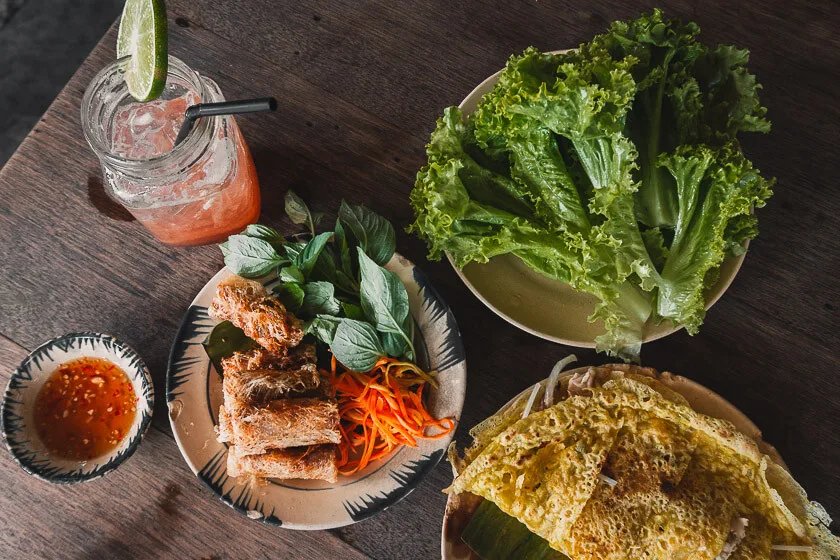
Follow us on Instagram!
2. Go Shopping in Ho Chi Minh City at the Markets
When in Vietnam, shopping at the local markets is something you have to try. It’s a great way to pick up souvenirs and gifts to take back home.
But visiting the markets is so much more than finding cheap, fake clothes. It’s the easiest way to fully immerse yourself in the local culture. Take your time to interact with the locals and learn how to barter with the shop owners. Ask the food vendors to make you their favourite dish and be prepared to learn more about local cuisine than any food tour could teach you.
Ben Thanh Market in District 1 is a huge market and it’s great, but it is certainly tailored to tourists. If you’re staying in District 1, this will be your go-to market, but we recommend exploring further afield. Tan Dinh market is a short drive away and offers a far more authentic experience.
At Tan Dinh, a lot of the vendors won’t speak English (unlike Ben Thanh where their jobs depend on it). You will find far more textiles and products the locals are likely to buy on a daily basis. There will be fewer tourists and the scam-artists will all be in District 1. It’s much more challenging, but you will find the experience here significantly more rewarding.
Check out our guide to shopping in Vietnam to find out all the things you must buy in Ho Chi Minh City. If you are wanting to get around Ho Chi Minh City (and Vietnam), I also recommend reading this guide to the best sim cards in Vietnam to ensure you have connection when you arrive.
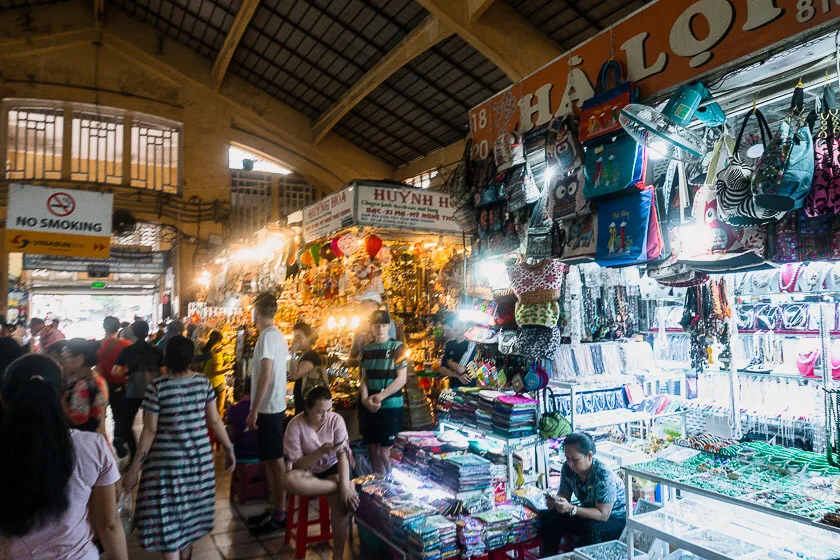
3. Visit the Notre Dame Cathedral
The Notre Dame Basilica was built between 1863 and 1880 during the French colonisation of Vietnam. The cathedral was built specifically to offer a place for the French colonists to attend catholic services.
The design of the cathedral is impressive, with two bell towers standing over 60-meters (196 feet) tall and topped with iron spires.
Make sure you chat with the staff, who are available during the week, to learn all about the history of the Notre Dame Cathedral, as well as Ho Chi Minh City and Vietnam.
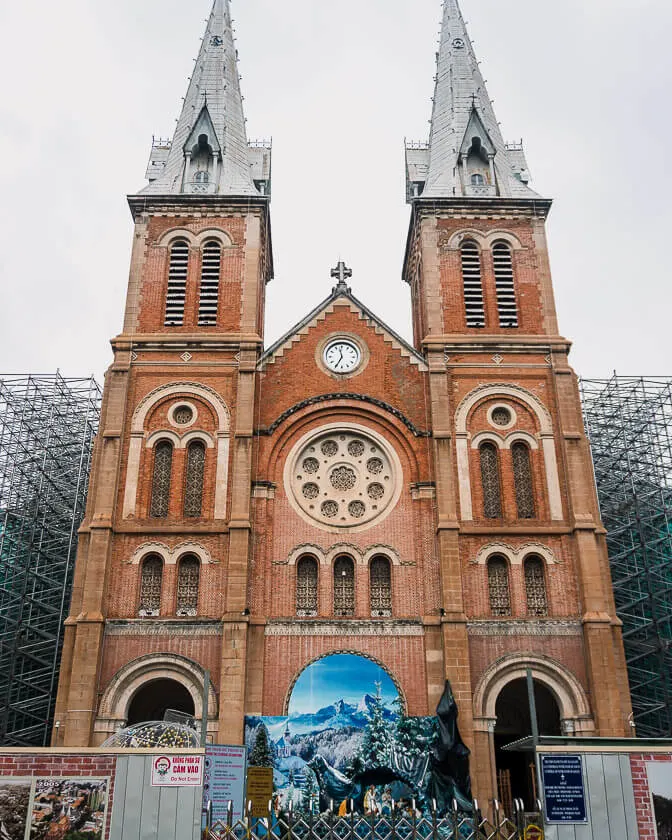
4. Saigon Central Post Office
The Saigon Central Post Office and the Notre Dame Basilica are right next to each other (as well as a McDonalds). This post office in Ho Chi Minh City was built just a few years after the Notre Dame Cathedral, in 1886.
A visit to the post office doesn’t sound like a top activity in Ho Chi Minh City, but trust us, it is well worth visiting thanks to it’s beautiful colonial design.
We love the architecture here as it is an awesome juxtaposition of French architecture next to the typical Vietnamese apartment buildings.
These buildings both serve as a friendly reminder that there is more to Vietnam’s history than the devastating Vietnam war.
The post office is still fully operational and a lot of tourists choose to take a few minutes to write and send a postcard back home. You will most likely beat the postcard home, but it will be a nice surprise for you when you’re suffering from post-travel depression.
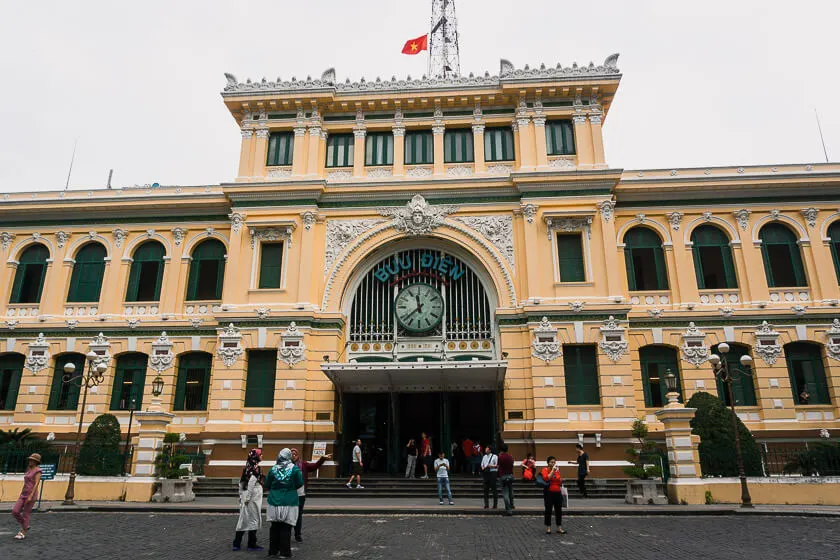
5. Visit the Reunification Palace (Independence Palace)
The Reunification Palace in Ho Chi Minh City is aptly named, as it symbolizes the reunification of North and South Vietnam. The end of the Vietnam War was marked in history when a North Vietnamese tank crashed through the gate of this palace in 1975.
Aside from the historical significance of the palace, the architecture is incredibly utilitarian and exemplifies its martial purpose during the war.
You can purchase tickets to explore the grounds at the main gate. This is a good option if you have time to spare, but if you’re restricted then you could just make a quick stop on your way to your next destination. It’s not the most exciting activity, but it’s one of those things you have to do in Ho Chi Minh City.
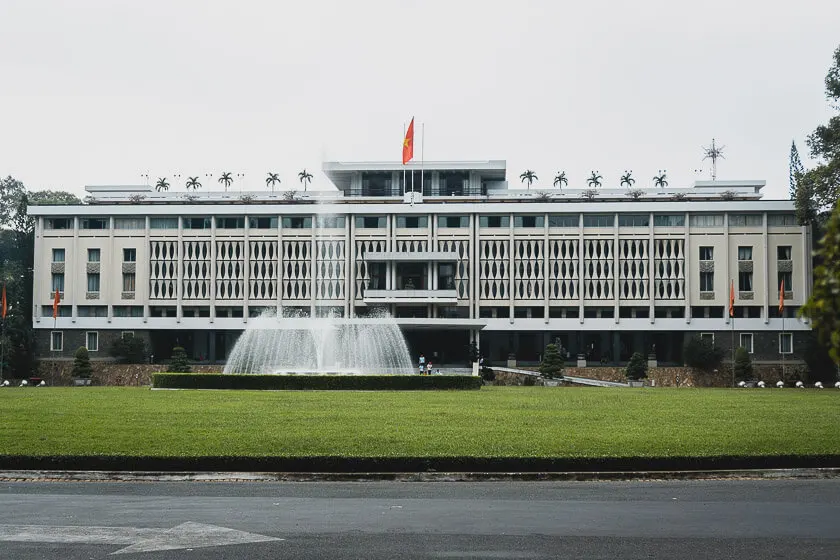
6. Enjoy the View From a Rooftop Bar
One of our favourite things to do in any big city is to get up high and take a look around. Rooftop bars are the most accessible way to do this.
Ho Chi Minh City is home to some decent sky bars. Not quite on the same level as the rooftop bars in Bangkok, but still very high and with incredible views.
Chill Bar is a good option with spectacular views from atop the AB Tower. Bear in mind, it’s not as ‘chill’ as it suggests and turns into a nightclub late into the night.
For the highest rooftop bar, check out EON Heli Bar in the Bitexco Tower. This is great if you have money to burn, as drinks here are on the pricey side.
For backpackers on a budget, The View Rooftop Bar located in Bui Vien Street is one of our favourites. It has cheap drinks and a much more laid-back vibe most nights.
7. Tour the Giac Lam Pagoda
There are many historic Buddhist pagodas around Vietnam, however, Giac Lam Pagoda is found right in the heart of the country’s largest city: Ho Chi Minh City.
Giac Lam Pagoda in Ho Chi Minh City is believed to be the oldest temple in Ho Chi Minh City, having been built in 1744. The name translates to “Feel the Woods Temple”, which is a particularly fitting name given its setting in a serene garden. It really is a nice escape from the hectic streets of Saigon.
In the front garden, you’ll find the sacred Bodhi tree towering over the grounds. Interestingly, this Bodhi tree was a gift to the temple from a Sri Lankan monk who visited in 1953.
During your visit, make sure to climb to the top of the 32-metre tall stupa. On the top floor, you’ll find a Buddha relic, as well as spectacular views over the neighbouring rooftops.
8. Take a Day Trip to the Mekong Delta
The Mekong Delta is technically just outside of the city of Ho Chi Minh City. The drive takes a few hours from District 1 (mostly spent in traffic), but it’s a good way to see what life looks like outside the tourist areas and one of our favourite things to do in Ho Chi Minh City.
We had to include the Mekong Delta as it is one of the most epic and authentic experiences you can find in all of Vietnam. Ho Chi Minh City is the nearest city and it is the perfect place to go to escape the hecticness of the big city.
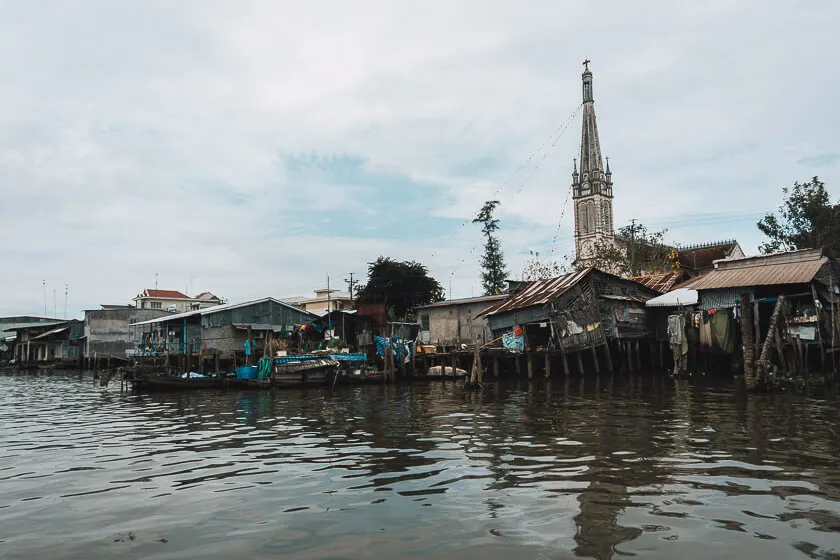
When in the Mekong Delta, you will get the opportunity to take a boat down the interconnecting canals of the river. There are floating markets selling everything from fruit and vegetables to conical hats and raincoats.
If you are taking a tour (which is probably best), then you will most likely get the opportunity to see how locals make coconut candy and rice wine (infused with whole snakes – gotta improve that virility…).
We recommend spending a night here to make the drive worth it. You won’t find 5-star accommodation, but we prefer to live more like the locals anyway.

9. Explore Thien Hau Temple
Thien Hau Temple, or officially known as Ba Thien Hau Pagoda, is a Chinese temple found in Ho Chi Minh City’s District 5.
This quaint Chinese temple was built in c. 1760, with major repairs throughout the 19th and 20th century. It was built to worship the Chinese sea goddess Mazu.
Intricate artworks, including carvings, lanterns and porcelain figurines decorate the exterior. Through the haze of incense, you can expect to find inside an altar to pay respect to Mazu, as well as numerous statues of the goddess herself.
There is no entry fee to the temple, which makes it a great thing to do in Ho Chi Minh City on a budget. It is often busy with a mixture of worshippers burning incense and tourists respectfully visiting the attraction.
10. Visit the Cafe Apartment in Saigon’s District 1
Standing tall and proud in the middle of Ho Chi Minh City’s District 1, you can find a somewhat daunting collection of shops. The building really sticks out as a giant square with signs plastered all over it. This is the Cafe Apartment.
It has abandoned building vibes, despite being packed with vendors, shops and cafes. We walked past about 10 times wondering what it was, before building the courage to go inside.
At the base of the building is a small alleyway. Down the alleyway, there are some stairs and a lift. You can pay 3,000VND to use the elevator, which is perfectly reasonable, but we’d recommend taking the stairs. This way you can easily explore every level.
The Cafe Apartment wasn’t designed for shops, so on each floor, there is just a row of doors and signs. You will find cute fashion boutiques, cafes, restaurants, book shops and more. Well worth a visit!
When you reach the top, decide on your favourite cafe and enjoy the view with a cold drink. Most cafes have a balcony overlooking the entire courtyard below with some impressive views.
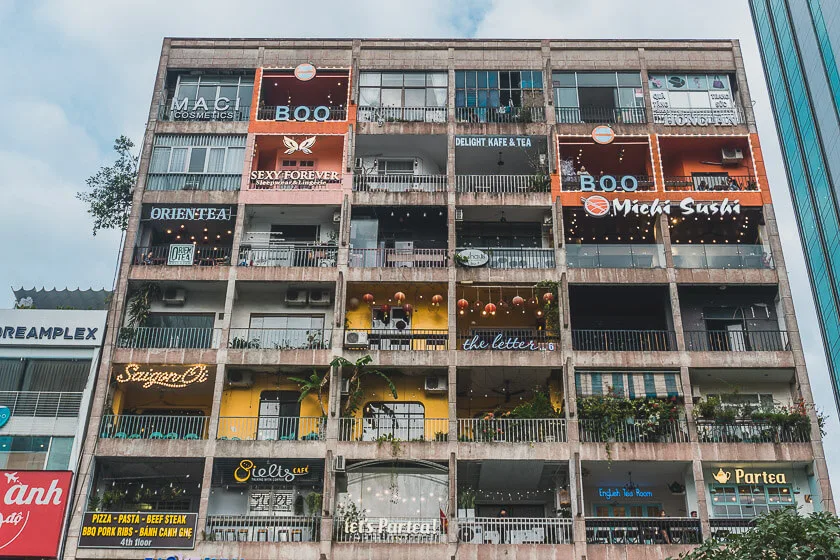
11. Tour the Museum of Vietnamese History
The Vietnam History Museum showcases Vietnam’s history before the war. As with many of Vietnam’s historical buildings, the Museum of Vietnamese History is visually pleasing thanks to its French-inspired design.
The location of the museum is conveniently right next to the zoo, making it suitable for tourists who plan to visit the zoo as well. Aim to set aside about 2-hours for exploring the antiques, including pottery, statues, instruments and even a mummy.
It’s an absolute must-visit when in Saigon as it offers a wider view of Vietnam’s history. Many people don’t look back past the 19th (or even the 20th to be fair) century. It is not surprising to learn that there is ancient history dating back centuries for Vietnam.
This history played a large part in underpinning what Vietnam is today, so it is worth taking the time to explore this relatively forgotten side of Vietnam.
Entry cost is a very reasonable 50k VND.
12. Visit All the Hipster Places in Ho Chi Minh City
Ho Chi Minh City is up and coming on the world scene when it comes to all things hipster. Expect to find street art, trendy cafes, quirky bars and markets filled with hand-made or locally-sourced clothes and products.
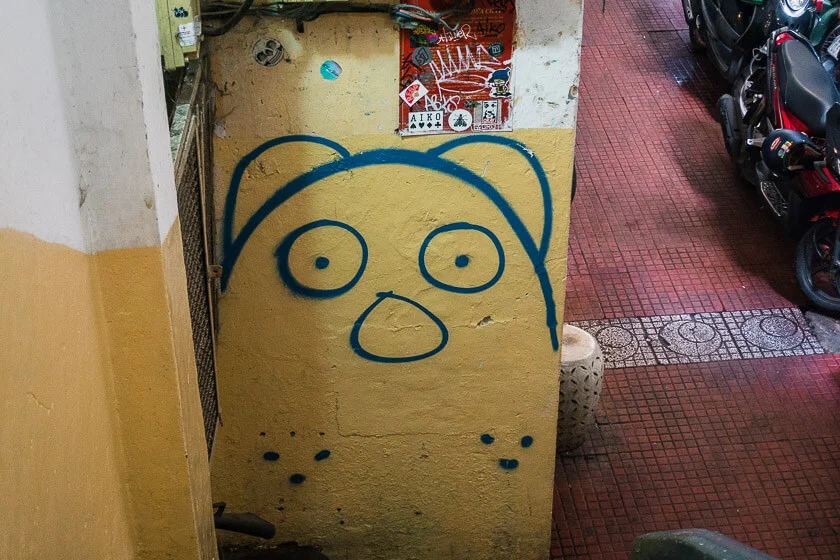
As much as we love Ben Thanh Market, seeking out the cute, local markets is a surefire way to find something of a higher quality. These markets are most easily found when walking the streets of Saigon’s District 1.
The Hello Weekend Market in District 1 and the Flea Market in District 7 are both great places to find hipster-y products.
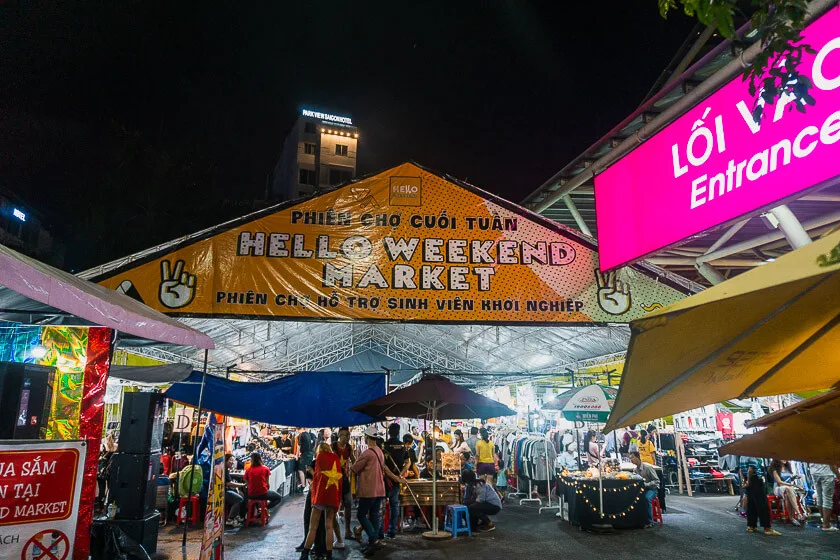
The Workshop is one of our favourite cafes, which is always packed with hipsters and coffee-connoisseurs alike.
13. Visit the War Remnants Museum
The Vietnam war ended less than 50 years ago, and the effects of it are still impacting the lives of many Vietnamese people.
Visiting the War Remnants Museum isn’t pleasant, but it is an amazing exhibition of the causes, origins, and effects of the war. The photos and propaganda on display here are powerful and are displayed to evoke an emotional response.
Often, there will be victims of Agent Orange volunteering their time at the museum to help raise funds and to educate visitors.
Although this won’t be the most enjoyable part of your trip, it will be one of the most memorable. Visiting the War Remnants Museum is something that should definitely be on your list.
14. Walk down the Walking Street (Bui Vien Street)
Walking Street is popular with foreigners, making it an incredibly touristy activity. During the day you will find backpackers eating, shopping and recovering from the night before. During the evening, these same backpackers will be letting loose at the countless bars lining the street.
The Walking Street is definitely worth visiting when in Ho Chi Minh City, and there are some amazing cafes and restaurants, but remember to venture elsewhere. This isn’t really a representation of Ho Chi Minh City, but it is interesting and can be a good place to explore or set up a base.
As we mention again later, it’s difficult to walk more than a hundred meters in Saigon without finding a cool, hipster cafe packed with expats, students and young professionals on their laptops. Our favourite, which is well worth a visit, was The Workshop. The coffee-scene in Ho Chi Minh City is next level (and super affordable), so make the most of it while you’re here.
If you ever find yourself wondering what to do in Ho Chi Minh City, try just going for a walk.
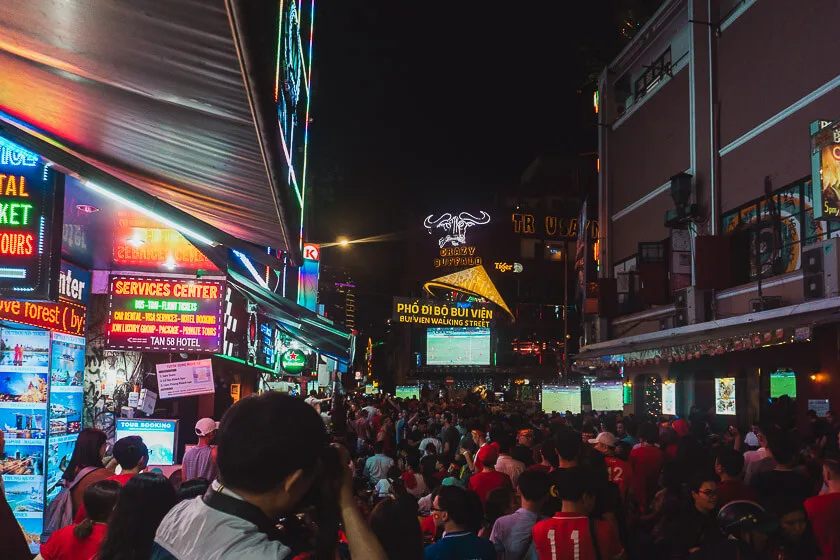
15. Party it Up For Cheap as You Soak Up the Ho Chi Minh City Nightlife
As with any large city, Saigon has a happening nightlife. Whether you’re after classy rooftops, seedy back-alleys, or hipster speakeasies, you’ll easily find the right place to enjoy some of the best things to do in Ho Chi Minh City at night.
Rooftop bars offer both chill vibes and some of the more upscale nightclubs in the city. Refer to point 6 for some of our favourites, or if you’re heading to Thailand, make sure to check out our article on the best sky bars in Bangkok.
The Caravelle Hotel and Sheraton Hotel each have some of the biggest and most popular casinos in Saigon. If you’re into gambling, then consider checking these out.
If you’re in District 1, you can look to party it up with other tourists on Bui Vien Street. Music plays and cheap drinks are available until the early hours of the morning. Apocalypse Now is a popular, albeit unsophisticated, night club in the heart of District 1 that is always a good time.
For a more sophisticated evening, the Saigon Opera House offers a wide range of performances including ballet, musicals, theatres and traditional dance. The Sax’n Art Jazz Club is a 10-minute walk from the Opera House and has excellent live performances from some of Ho Chi Minh City’s best jazz musicians.
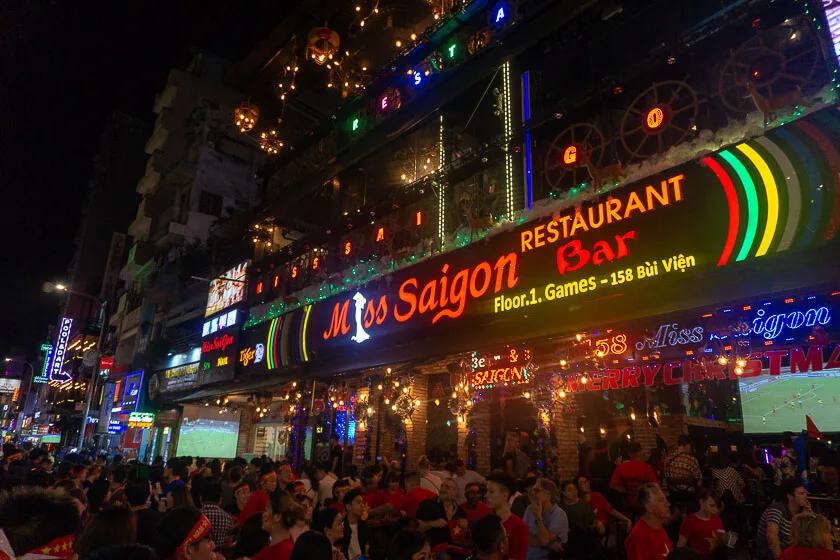
16. Explore the cafes and shops in creepy locations
It seems common in Ho Chi Minh City for the cutest cafes, restaurants, and shops to be found down dark alleyways and up creepy staircases. The Cafe Apartment above is just one great example of an unusual location.
We found some of the best restaurants we ate at by exploring alleyways that we would have preferred to avoid. Mountain Retreat was one such restaurant that was difficult to find, but home to marvellous views and delicious food.
They also don’t tend to invest heavily on the stairs or the entrances to these buildings – so expect to find some creepy staircases – and a lot of stairs.
17. Crawl through the Cu Chi Tunnels
The Cu Chi Tunnels are quite a drive from the popular tourist spots in District 1, but it is a truly unique experience in Ho Chi Minh City that you won’t find anywhere else in the world.
When you get here, you will have the opportunity to look around and envision what it was like to be a Vietnamese (or even American) soldier during the Vietnam War. You will be allowed to crawl through tunnels originally used by Vietnamese soldiers (or at least, you can try to – you might get stuck!) to hide from the Americans.
They also have displays of the various traps the Vietnamese invented to kill, disembowel and maim American soldiers.

We personally chose not to do this, but you will have the opportunity to shoot some real rifles before you leave – in case this activity was on your bucket list.
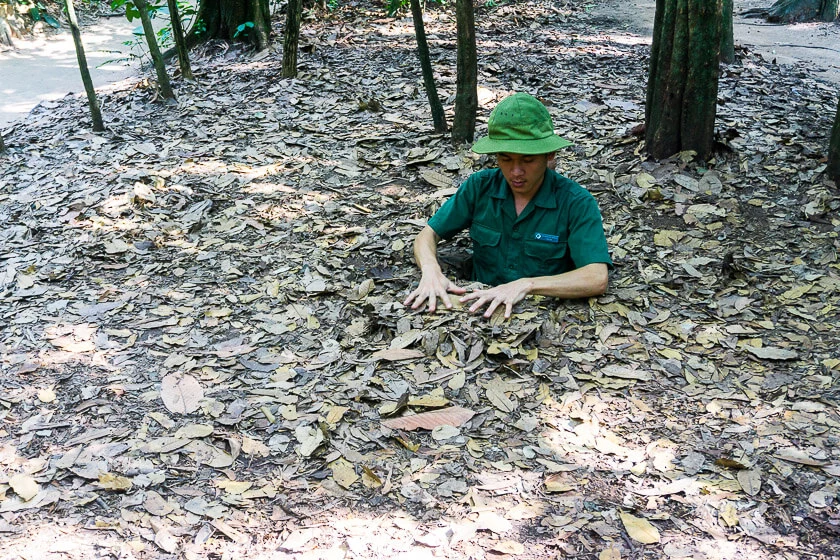
18. Try Vietnamese Coffee – and Also Try Non-Vietnamese Coffee
Most people don’t think of Vietnam for its coffee. But most people also don’t realize that Vietnam is the second-largest producer of coffee in the world – after only Brazil and beating out Colombia, Indonesia, and Ethiopia by a huge margin.
This is because Vietnam produces a type of bean called Robusta, commonly considered to be of a lower quality to the popular Arabica beans. This bean is typically bitter and used as the primary bean in most forms of ‘instant coffee’.
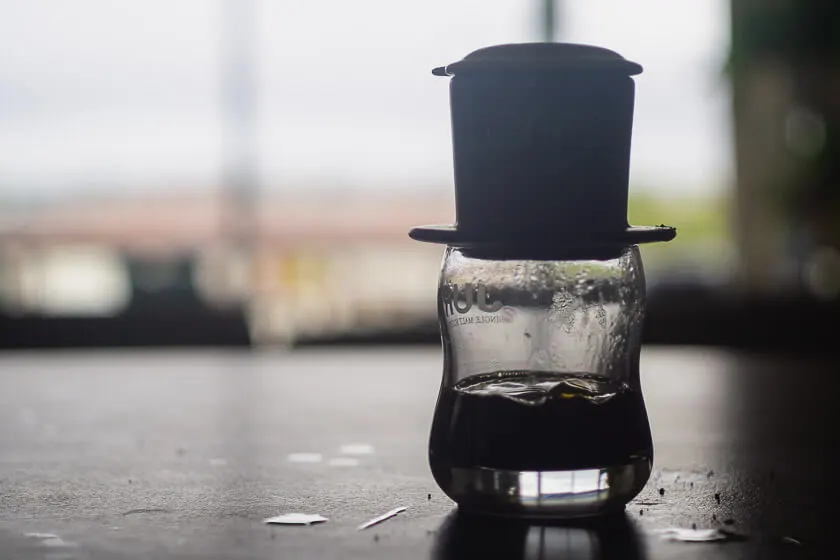
The Vietnamese, however, learned that Robusta beans are quicker and easier to grow resulting in larger yields. By adding sugar to coffee made with Robusta beans, you can counter the bitterness creating a delicious and refreshing beverage.
As a result, Vietnamese coffee was born. It is now prepared with Robusta beans drip-brewed over condensed milk. It can be consumed hot, but thanks to Vietnam’s high temperatures, iced coffee (Ca Phe Sua Dua) is extremely popular with tourists and locals alike.
You can order Ca Phe anywhere in Vietnam, and for the most part, it tastes the same – always delicious.
We would also recommend looking outside the box, however, as the Vietnamese coffee scene has improved drastically. The Workshop is a specialty cafe located in Ho Chi Minh City. This is the coolest cafe we’ve ever been to, and the coffee here is amazing – but it isn’t your typical Vietnamese coffee.
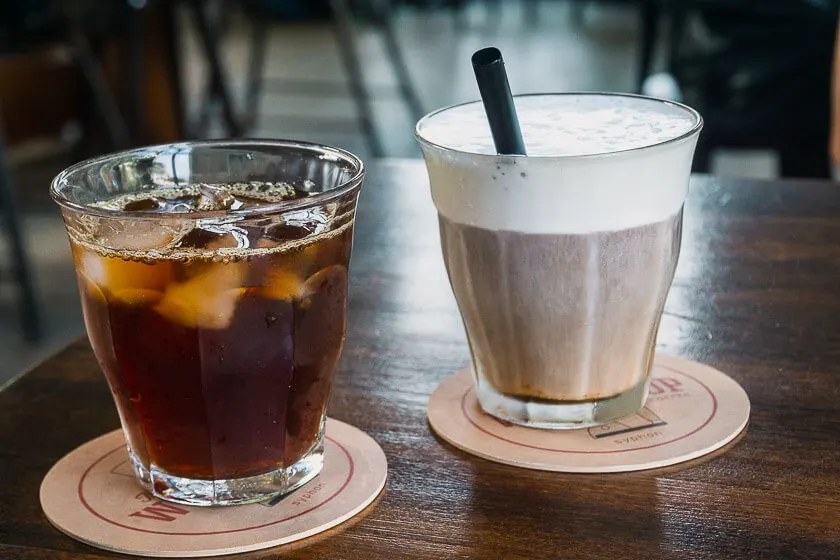
19. Explore the Cao Dai Temple
Most people don’t realise that a unique religion was founded in Vietnam just outside of Ho Chi Minh City. This minority religion consists of an estimated 4-6 million Vietnamese devotees.
About 3 hours outside Saigon’s District 1, within the Cao Dai Holy See, is the Cao Dai Great Temple. This location is where the religion was founded in 1926.
The Cao Dai temple is one of the most unique in the world, thanks mainly to the fact that it contains statues and decorations typical of various other religions. Expect to find statues of Buddha, images of saints and dragon encrusted columns.
The temple is decorated extravagantly with clouds on the ceiling and colourful tiles. Despite the devotion to Buddha, the temple is laid out like a Catholic cathedral.
A highlight here is watching the devotees pray. People dress according to their rank within the religion, resulting in robes ranging from white to brightly coloured blues, reds and yellows.
The temple is well worth visiting as one of the most unusual things to do in Ho Chi Minh City, but it is located quite far from District 1. Your best bet is to combine it with a trip out to the Cu Chi Tunnels.
20. Climb the Bitexco Tower
The Bitexco Tower is a staggeringly high building – the second tallest in Ho Chi Minh City and fifth in Vietnam, making it an attraction in itself.
This monstrous tower stands out in the heart of District 1 and was even named by Thrillist as the second coolest skyscraper in the world.
By all means, enjoy the view from the ground, but if you aren’t;t afraid of heights you can make your way to the top.
The Skydeck is an observation viewpoint on the 49th floor. It’s a popular tourist hotspot, so instead, we’d recommend heading to the EON Heli Bar on the 52nd floor for an awesome experience looking out over Ho Chi Minh City.
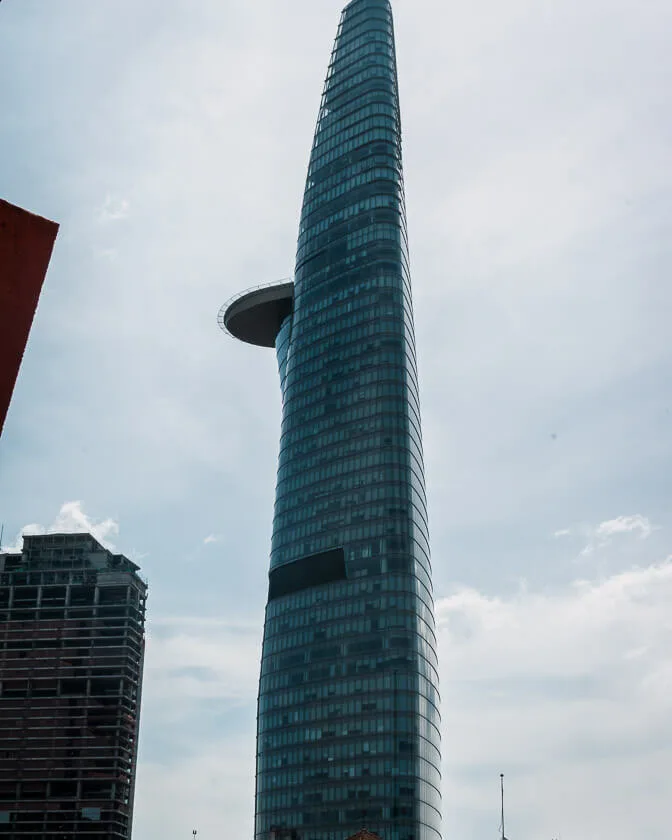
21. Go to the Museum of Ho Chi Minh City
The Ho Chi Minh City Museum is a great example of beautiful architecture in Saigon. The museum is one of the grandest buildings in Ho Chi Minh City, having been built in 1885 and inspired by French, colonial design.
Previously, the museum has gone by different names. These names included Gia Long Palace – it was not originally built as a museum – and the Revolutionary Museum.
The Ho Chi Minh Museum leads visitors through the history of Vietnam, including Ho Chi Minh himself and the two wars (between France and America).
There are galleries dedicated purely to the Vietnam War and French history. You will find historical ceramics, ancient maps and marriage costumes belonging to various ethnic groups.
The entrance fee is around 40,000 VND, or $2 USD.
22. Visit Phu My Hung and Starlight Bridge
Phu My Hung is an up and coming suburb in Ho Chi Minh City’s vibrant District 7. It’s a nice clean location, great to stay in if you’re a family or expat. It’s a relatively safe neighbourhood, by Saigon’s standards, and is nice to take a stroll in the evening.
The star of the show is the Anh Sao Bridge, or Starlight Bridge, as it is one of the best attractions in Ho Chi Minh City’s District 7. It’s a beautiful bridge in a very nice park. The bridge lights up offering plenty of great Instagram photo opps.
We also heard there is an impressive light show, but can’t really recommend waiting around for it to happen.
23. Take a Cooking Class
Vietnam is renowned all around the world for its delicious food. The most famous of which include pho, banh mi and banh xeo.
In Ho Chi Minh City, you’ll find some of the best places to eat in the country, so it makes sense that it’s also a great place to learn how to cook some of these dishes.
It’s easy to find a cooking class in Ho Chi Minh City. Many classes are offered by your hotel or guest house, or you can search TripAdvisor. That said, a great way to find a good cooking class (and often at a good price) is to ask at your favourite restaurants.
We often see signs up at restaurants advertising cooking classes on certain days, and if you know the food is good then you can be confident that you’re learning from a good chef.
Many of these tours also include a guided trip around the local market to find fresh produce for your dishes. Although this won’t be very helpful when you get back home, it’s a great way to experience the local side of Ho Chi Minh City.
24. Visit Turtle Lake at Night
A popular place for locals, Turtle Lake is a nice park with a water fountain. Don’t expect to find turtles or a lake, however, as you will be very disappointed.
It’s a lively place with young locals loitering and eating street food. As a tourist, you will want to pay a visit after 7 pm and try out some of the local street food on offer – if you think your stomach can handle it!
It’s not a pretty place (as the name might suggest), but it’s a great way to enjoy a meal and chill in Ho Chi Minh City with the locals.
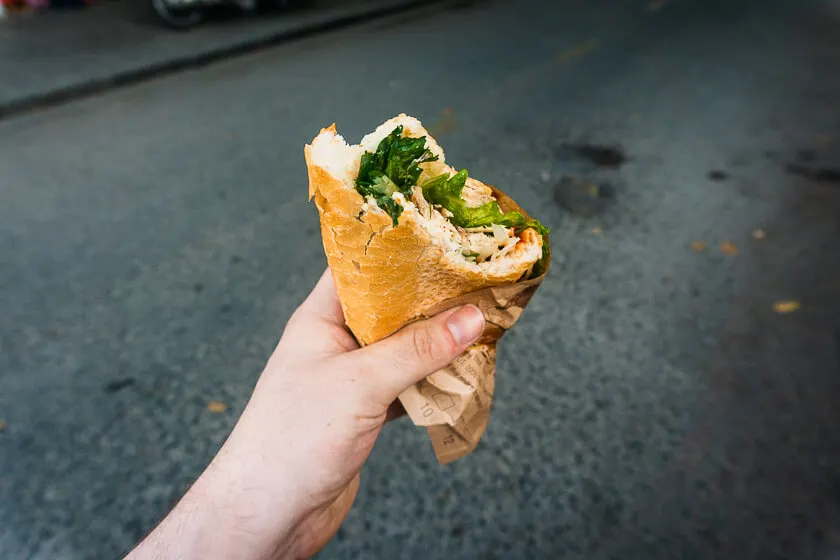
25. Get Educated at FITO Museum (Museum of Traditional Vietnamese Medicine)
The Museum of Traditional Vietnamese Medicine is one of the few privately owned museums in Ho Chi Minh City. It is housed in a 5-storey, traditional Vietnamese-style home.
The design of the house itself is immaculate, with wooden carved decorations and detailing all throughout.
The museum itself houses over 3,000 Vietnamese medical tools, manuscripts, manuals and guides used by Vietnamese medical professionals throughout history. They document and display the various medicinal herbs and methods used in traditional Vietnamese medicine.
It is a great place to spend a few hours to learn all about the history of medicine in Vietnam. There are a few different hands-on activities here. You can try your hand at grinding medicinal herbs with a sharp stone.
It costs 50,000 VND to enter, which is well worth it for the amount of knowledge contained here and the level of care and detail that has gone into preserving both the house and the contents of the museum.


Leave a comment